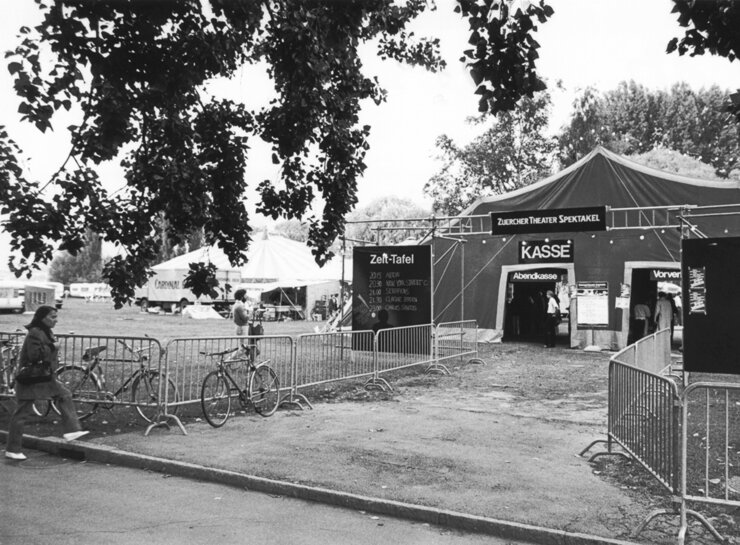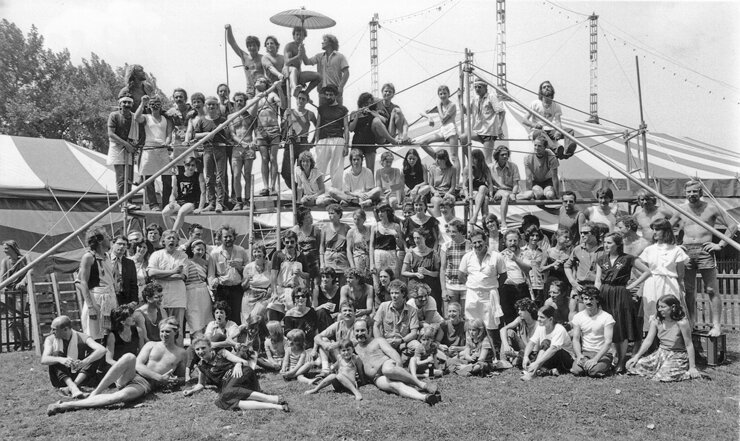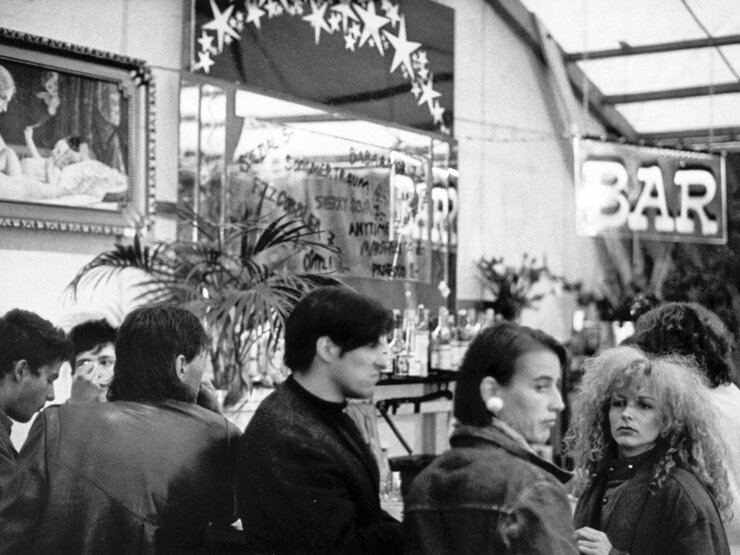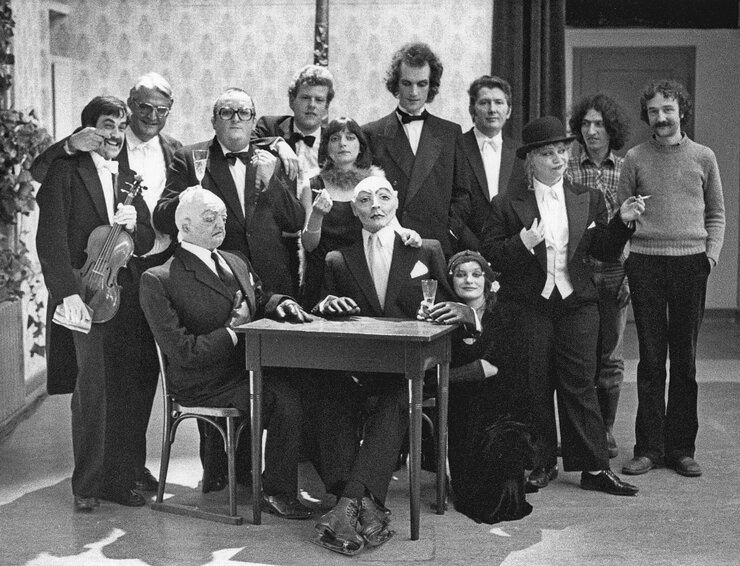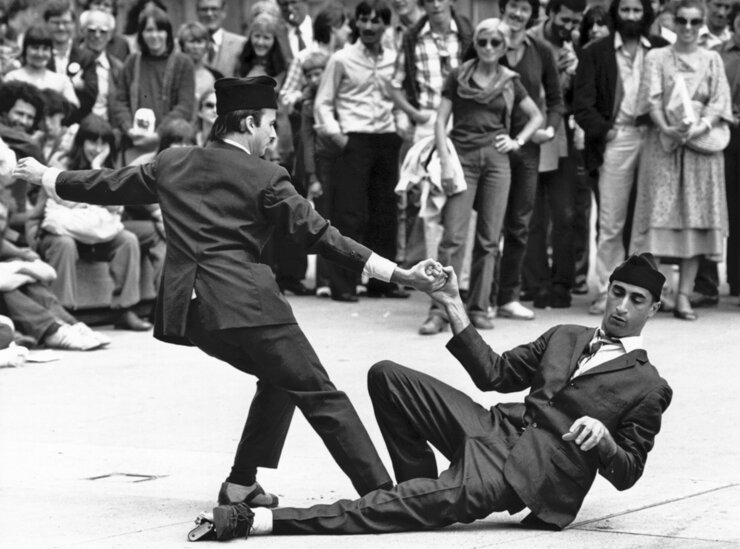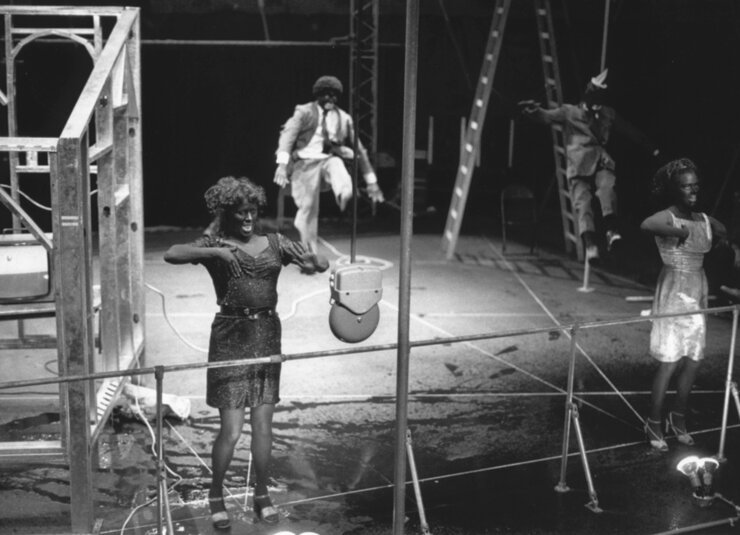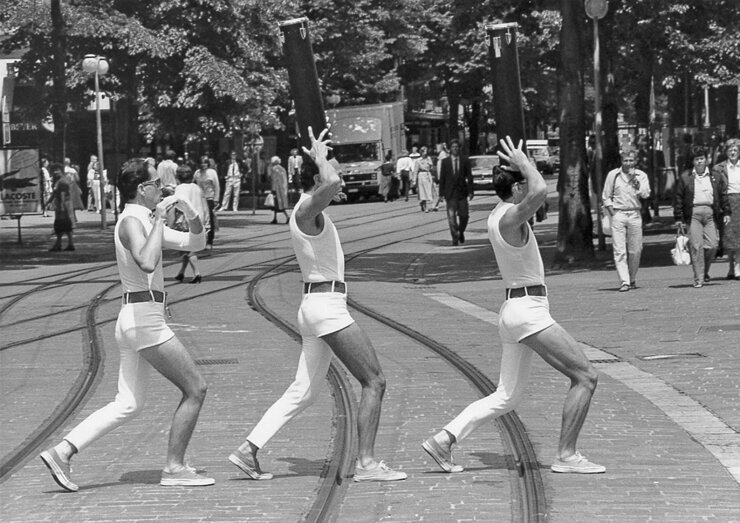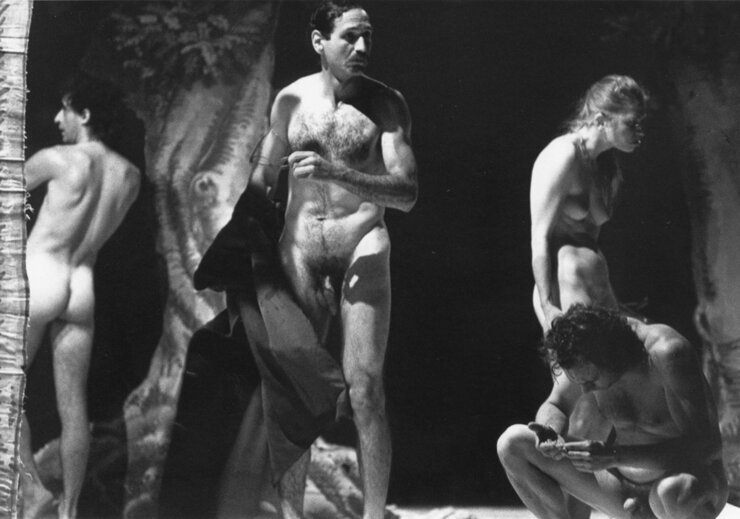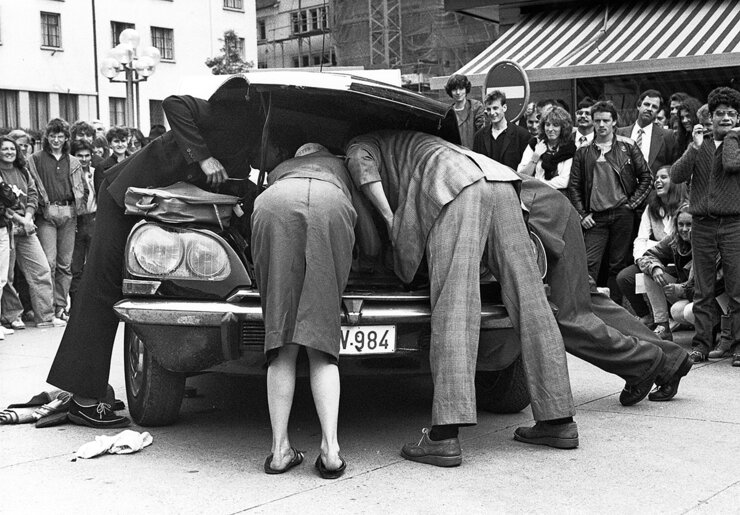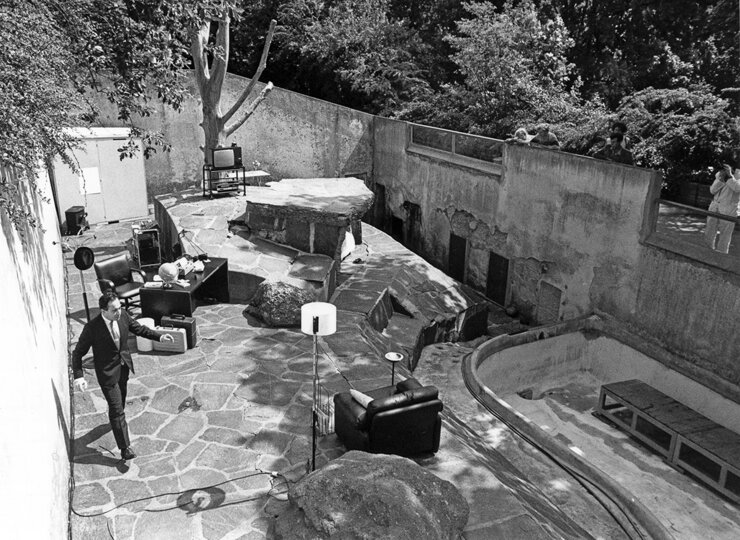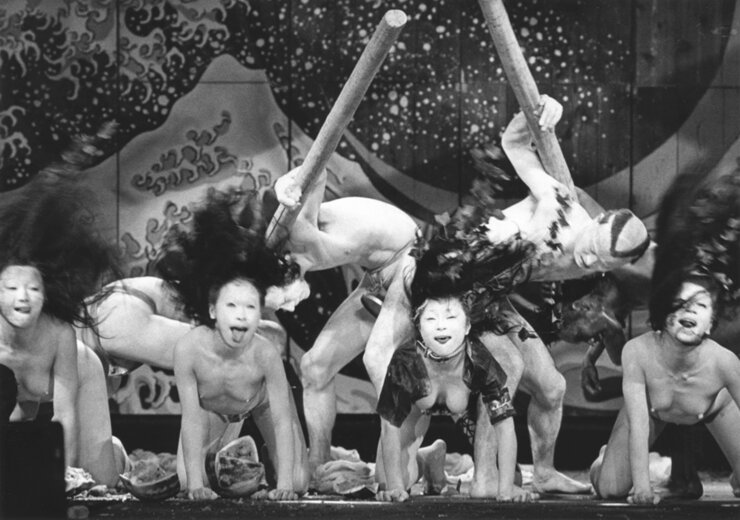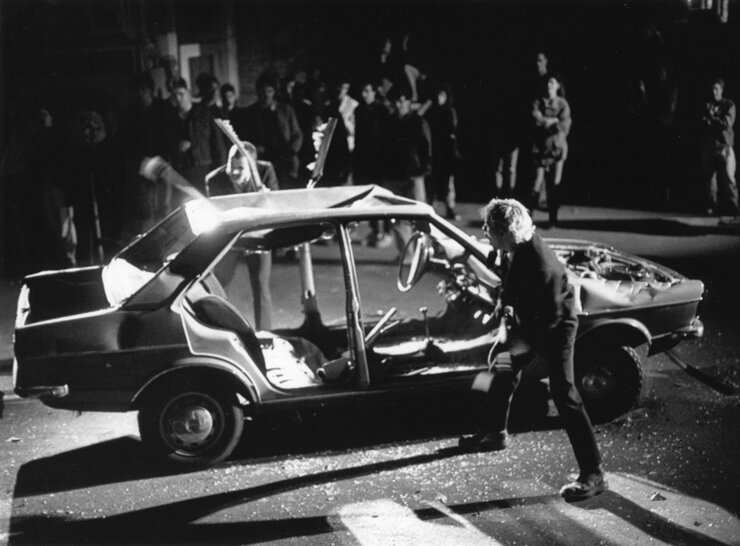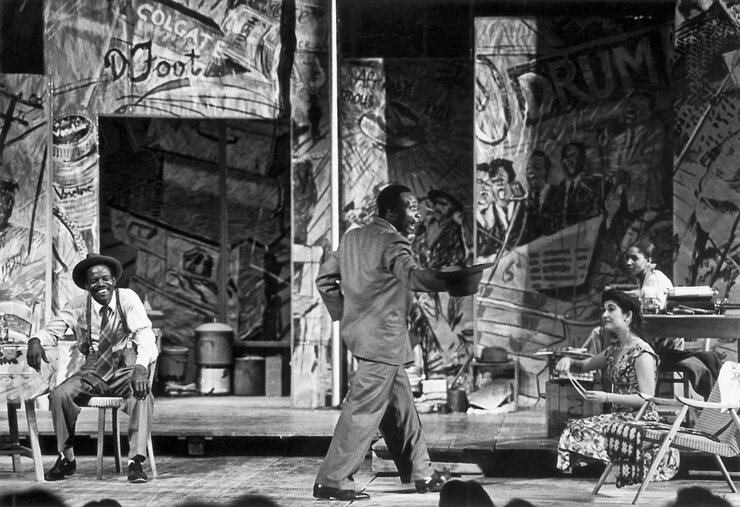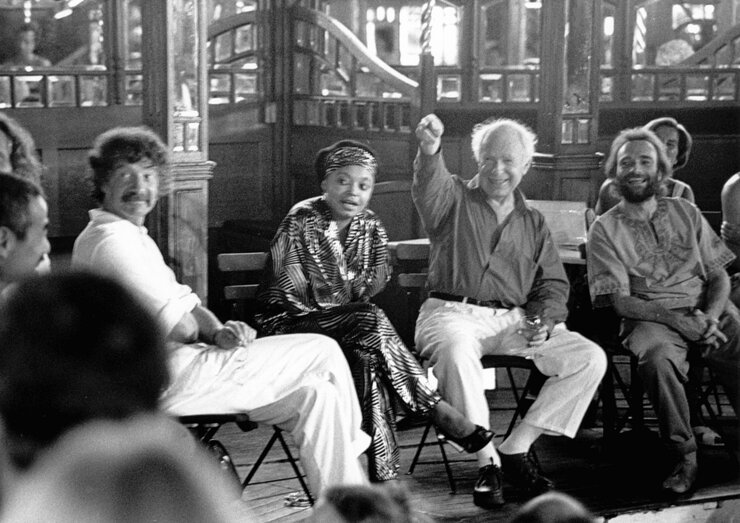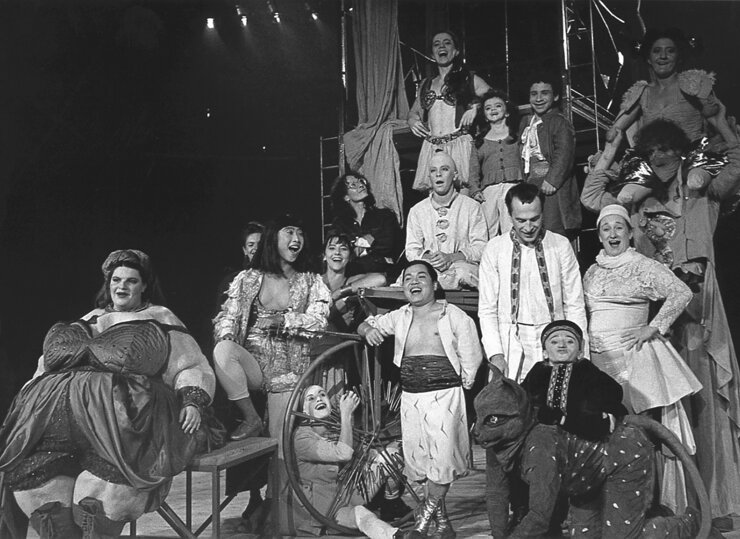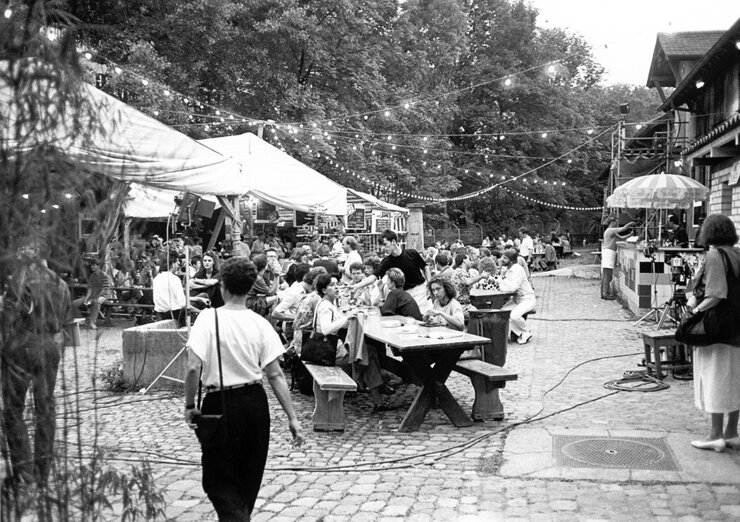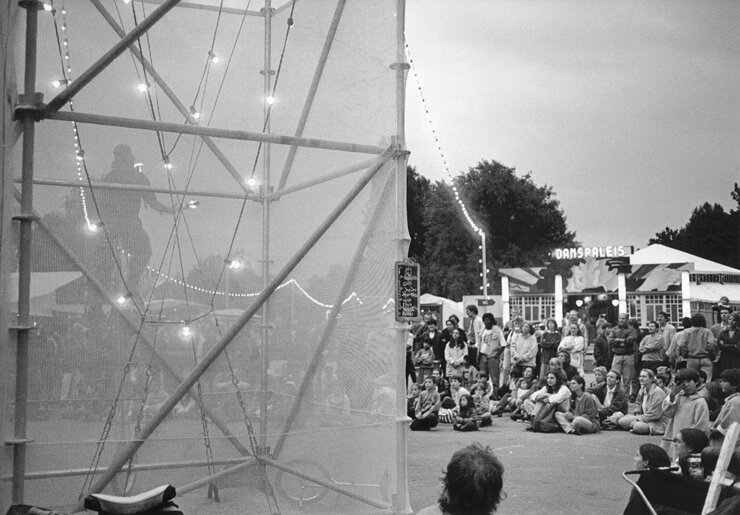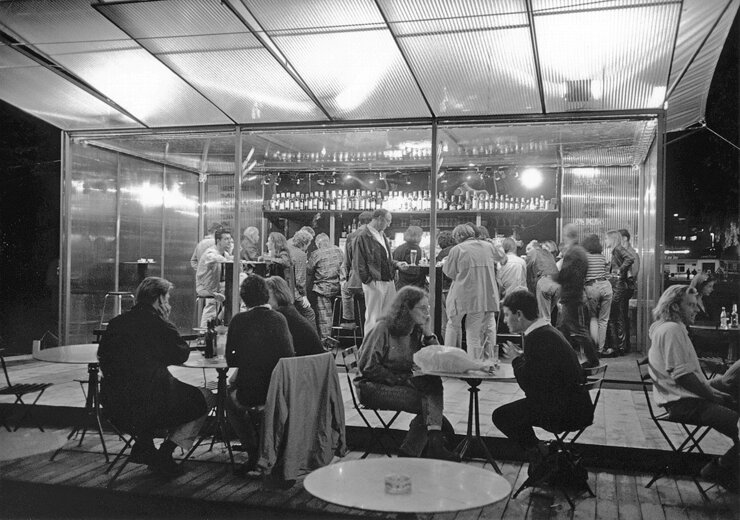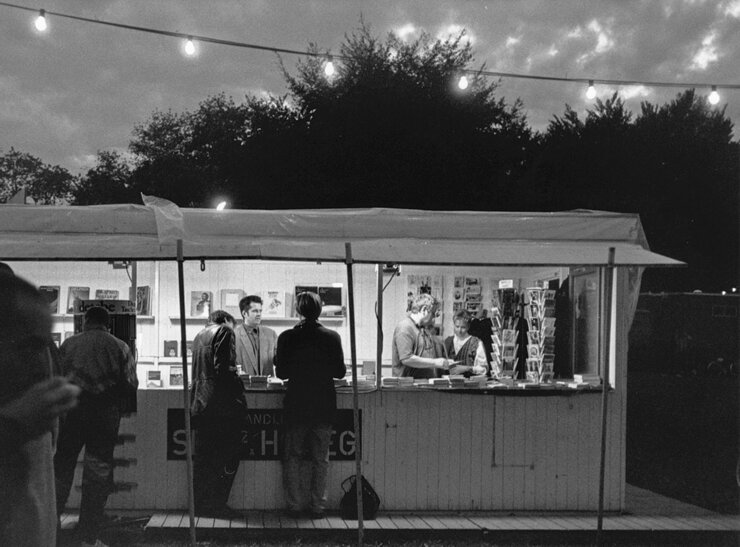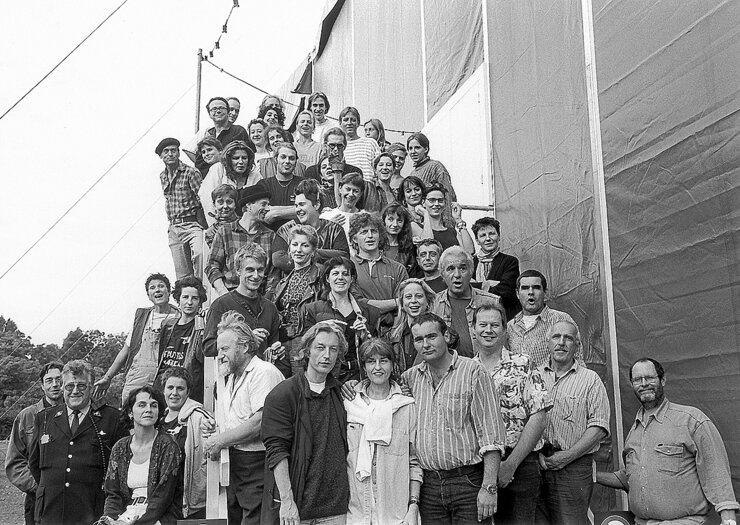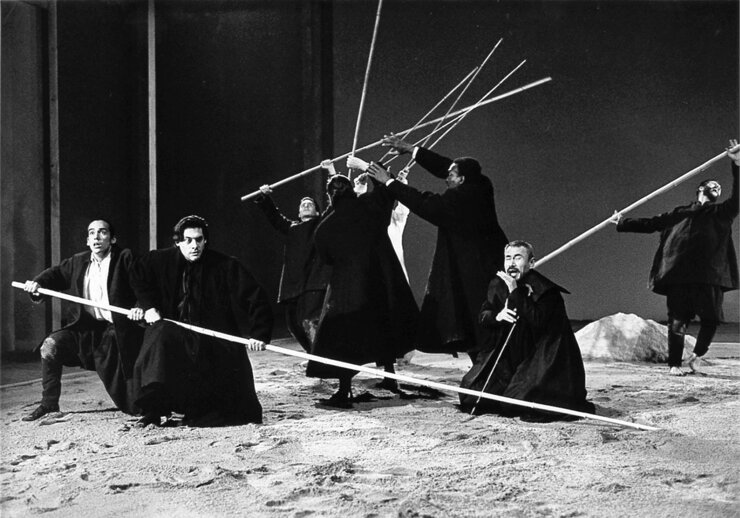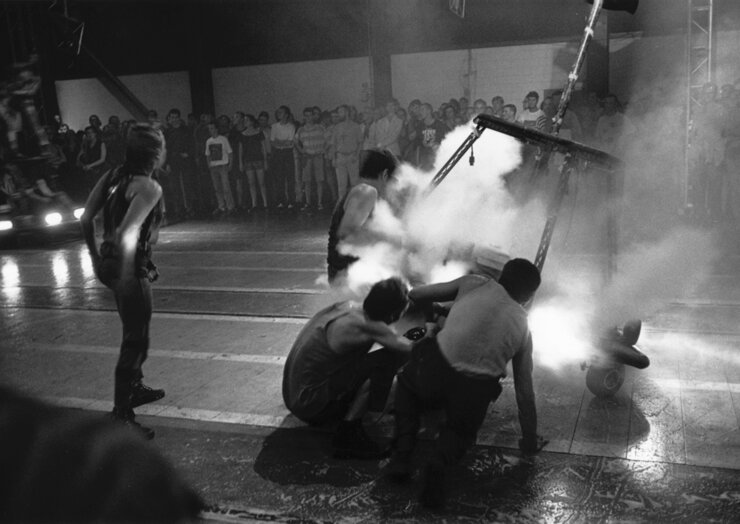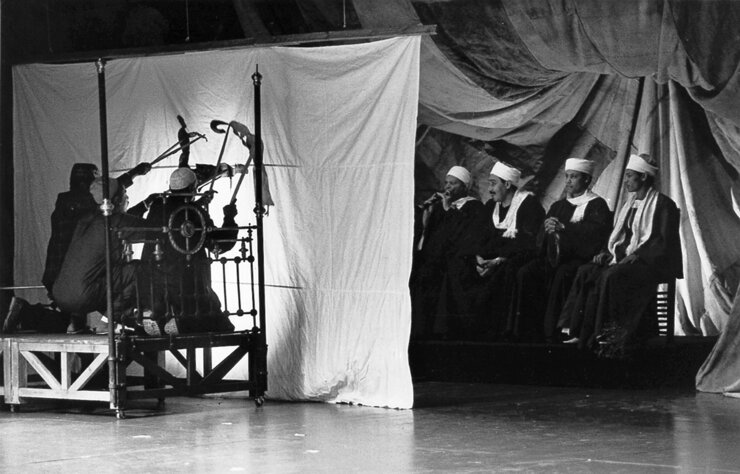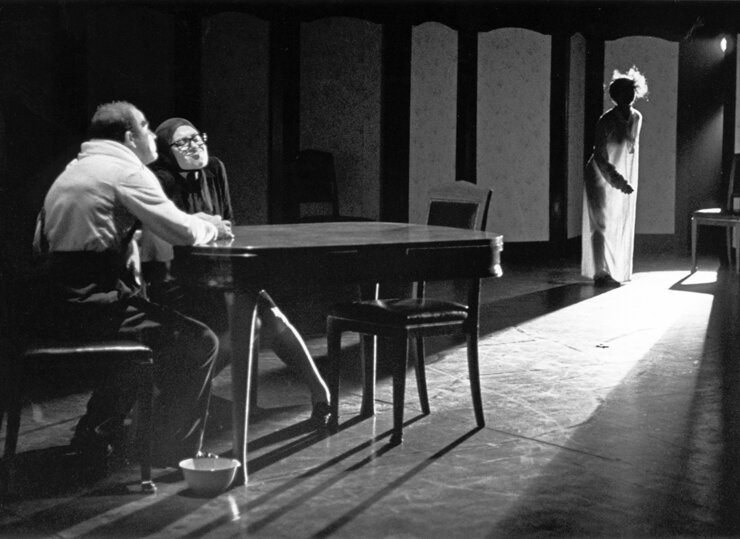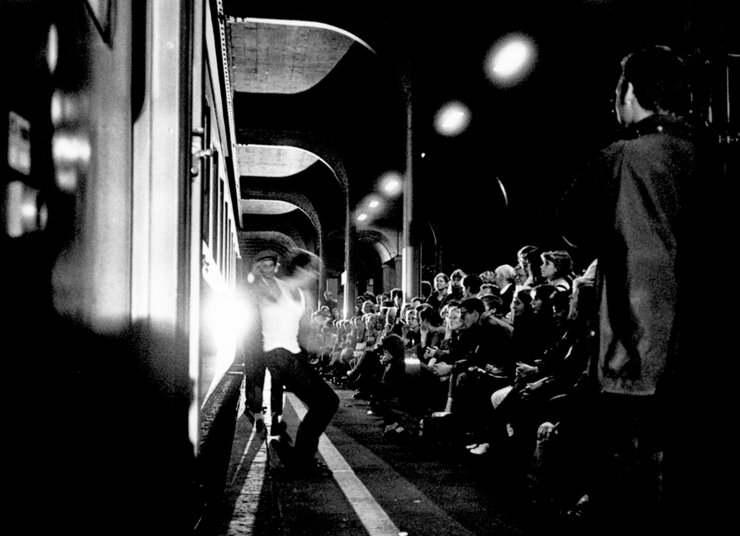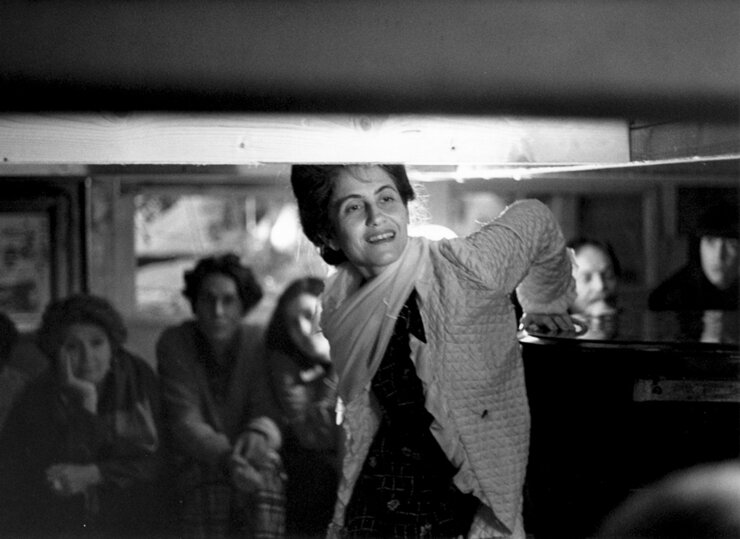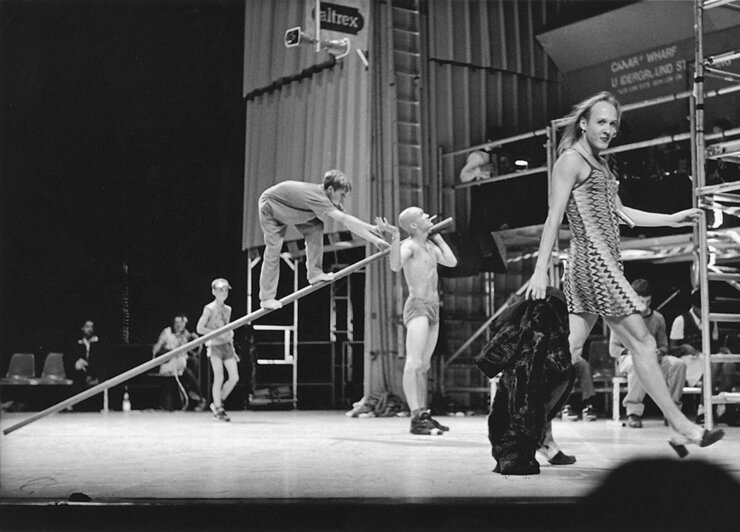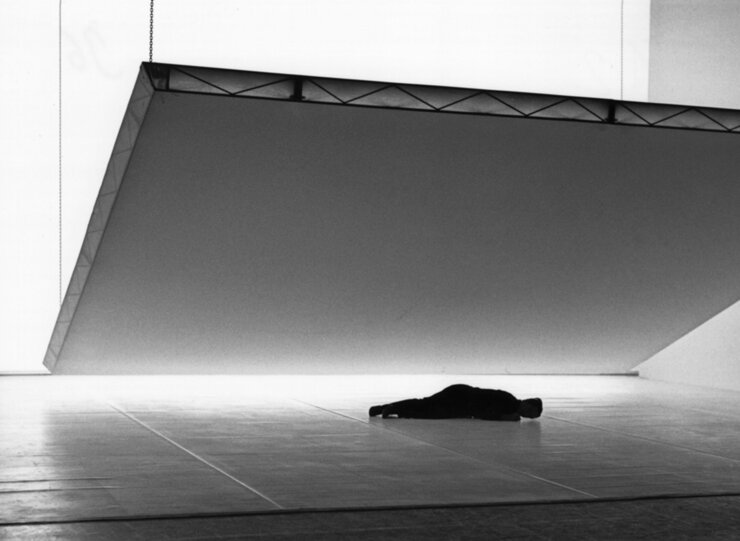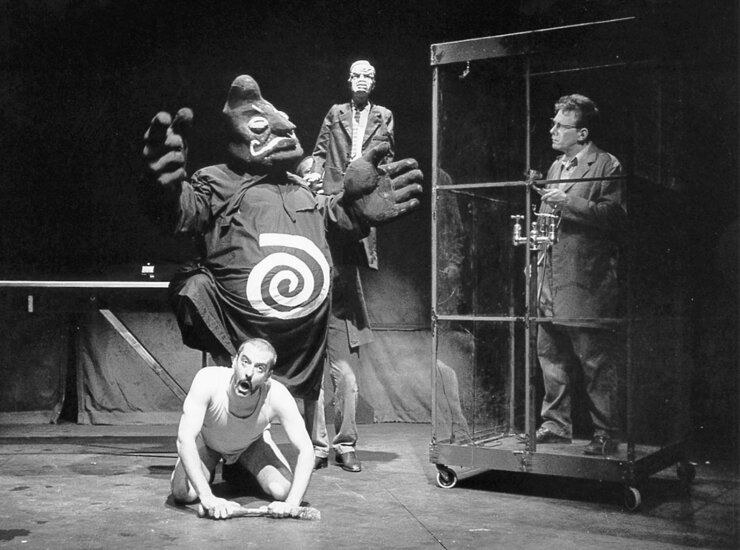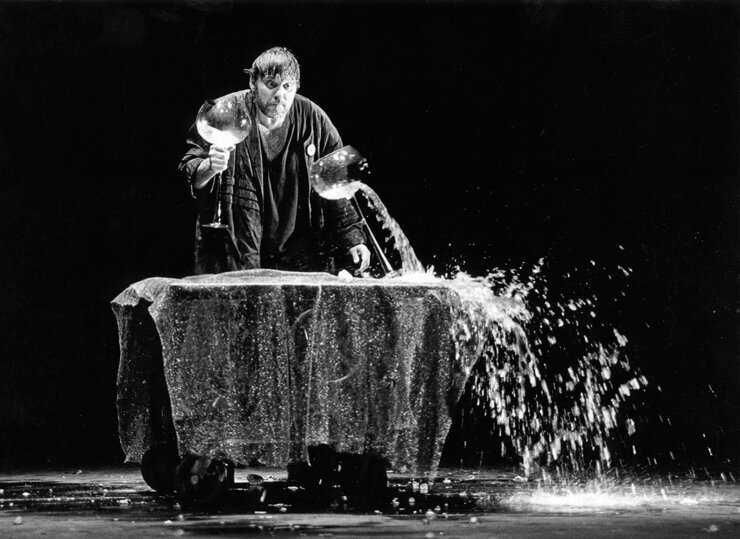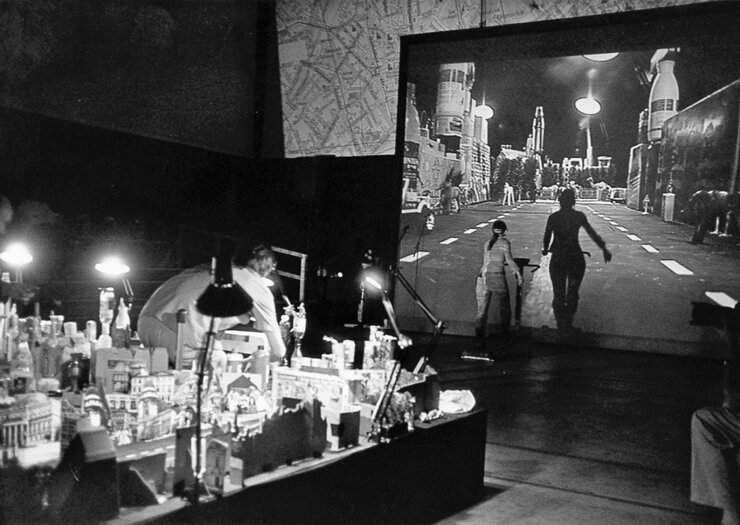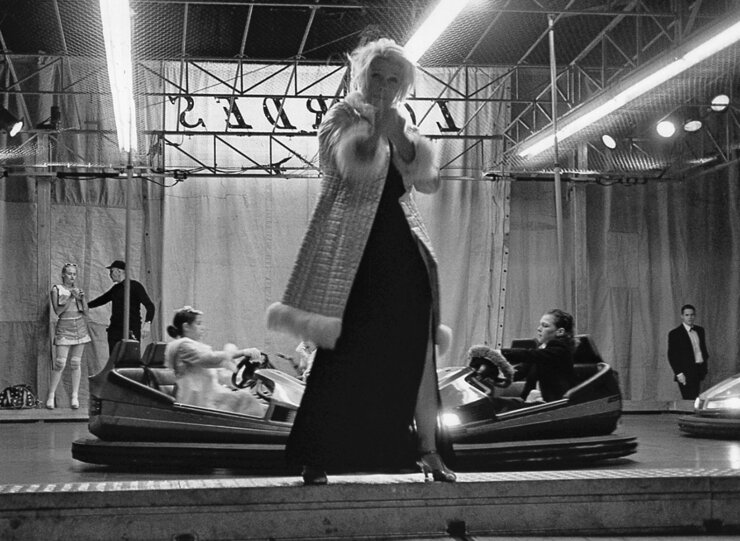1980-1989
The first Zürcher Theater Spektakel lasts eight days and takes place from 26 June to 2 July 1980, that is between the former Junifestwochen and the summer holidays. The founding team comprises theatre expert Jürg Woodtli, Wolfgang Wörnhard from Tages-Anzeiger and Nicolas Baerlocher of the Mayor's Department Zurich. Venues are three circus tents set up on the Landiwiese and the theatre of the Rote Fabrik. The eight-day programme, put together by Jürg Woodtli, Nicolas Baerlocher and Rolf Derrer, features 17 companies from Europe, the US and from Switzerland, such as Jango Edwards (USA), Farid Chopel (Algeria), Le Grand Cirque Magique (France) and Varieté Zirkus Aladin (Switzerland).
The Zurich audience is electrified by this new form of theatre and dance productions and flocks to the Landiwiese in great numbers: 12 500 tickets are sold during the first year. The following year, the festival duration is increased to 10 days and ranges between 12 to 18 days until the end of the eighties.
Jürg Woodtli's excellent knowledge of the international independent theatre and dance scene characterize the programmes of this decade. Artistic personalities and newly discovered talents from the off-theatre scene cause sensations with their idiosyncratic works. The programmes display a wide range of artistic expressions and handwritings: They include politically involved companies such as the Market Theatre (1987) from South Africa, the Catalan madmen of La Fura dels Baus (1985, 1988), the video-theatre pioneers of the Wooster Group (1983) from New York as well pioneering theatre authorities such as Peter Brook («Mahabarata, 1987) or Forced Entertainment (1987). Companies such as Spatz & Co., Sgaramusch or theatre artist Peter Rinderknecht demonstrate that theatre for young people can me much more than just reenacted fairytales.
The festival develops rapidly. The budget triples, the number of venues has raised from three to seven by 1988; five instead of two restaurants and bars serve the numerous visitors on the Landiwiese. The festival direction proves great inventiveness in creating new spaces for theatre. In 1985, the shipyard (Werft) of the Lake Zurich Navigation Company is used as a venue for the first time. In 1987, the vacant riding hall at the Gessnerallee is added. Various mobile constructions brought by the performing companies add further variety to the Landiwiese.
Important events
1982 Cornelia Howald leaves the Tages-Anzeiger to join the Theater Spektakel and takes over the administration of the festival.
1885 The festival lasts 21 days. A one-off event.
1987 The restaurant «Tao Yuan» with its Asian cuisine participates for the fist time.
1988 Res Bosshart and Werner Hegglin join the executive team. Werner Hegglin replaces Rolf Derrer as technical director.
1989 Jürg Woodtli leaves the executive team to join the newly opened Theaterhaus Gessnerallee. Res Bosshart becomes artistic director.
1990-1999
The Zürcher Theater Spektakel has become an established event in the cultural agenda of the City of Zurich. Members of the executive team are Res Bosshart, Werner Hegglin and Cornelia Howald. The programme committee, acting as an advisory body, consists of the executive team, the founding members Jürg Woodtli and Nicolas Bärlocher as well as Sandro Lunin (1993-1998), Esther Schmid (1990-2001) and Barbara Weber (1990-2001). In 1990, Markus Luchsinger, co-director of the Schauspielhaus Keller from 1985 to 1989, joins the executive team. Until 1994, he shares the artistic direction of the festival with Res Bosshart. He characterizes the programming of this decade and opens up new artistic dimensions for the festival. Performances by the Acco Theatre Centre from Israel («Arbeit macht frei vom Toitland», 1996) and the Japanese choreographer Saburo Teshigawara (1996) shake up the audiences. The Theater Spektakel is one of the first festivals to present the bewildering works of Socìetas Raffaello Sanzio from Italy («Amleto» 1992), the choreographies of the dance revolutionary Alain Platel & Les ballets C. de la B. («La Tristeza Complice», 1996) or the creations of great talents from Eastern Europe such as Eimuntas Nekrosius or Alvis Hermanis. In 1991, Al Warcha from Egypt is the first company from the Arabic world to perform at the festival.
The venues undergo big changes during this decade. The small circus tent was already replaced by the Pavillon in the 80s. In 1995, the time is up for the big circus tent. With around 900 seats, the Halle Blau takes over the role of the big venue. The same year, the Danspaleis becomes one of the permanent venues on the Landiwiese. In 1994, the Saffa Island is used as a performing space for the first time. Besides the Rote Fabrik, Gessnerallee and Werft, other locations fitting specific productions are used: The train station of Wiedikon (Compagnia Giorgio Barberio Corsetti, 1994), the synagog in Lengnau and the tunnel under Zurich's main station (Akko Theater, 1996) or the arsenals of the barracks (Enrique Vargas, 1998). In 1997 and 1999, the SEV-Halle Tiefenbrunnen, today home of the Zurich Chamber Orchestra, is used as a festival venue. For the 20th edition of the festival in 1999, the Schaubühnchen opens as venue for children's theatre.
The «Tao Yuan», the «Bayou» (later «Bohemia» by Daniel Kehl and Two Spice Company), the restaurant by Christine Muser and gmt-Party-Team (today «L’Andis») and the wine bar by Jürg Stacher (today «Le cochon vert») are the cornerstones of the gastronomic establishments during the 90s.
Important events
1990 Due to a historic exhibition, the Theater Spektakel does not take place on the Landiwiese.
1991 The Patrons Association of the Zürcher Theater Spektakel is founded thanks to the driving force of the advertiser Hermann Strittmatter.
1994 Res Bosshart, co-director of the festival with Markus Luchsinger since 1990, leaves the executive team. Markus Luchsinger takes over the artistic direction.
1995 As of this year, the festival's duration is set to 18 days.
1996 Zürcher Kantonalbank and Schweizer Rück, today Swiss Re, become partners of the festival. // Der ZKB Patronage Prize of 20 000 Swiss Francs is awarded for the first time. // The «Röhrlibar» complements the gastronomic offer for kids and families.
1997 The festival boat, sponsored by the ZKB, is put into operation.
1999 20th edition of the festival. On the occasion of the jubilee, a new venue for children's theatre, the Schaubühnchen, opens. // The Theater Spektakel goes online: For the time being, there is only information, no tickets.
2000-2007
The first festival of the new millennium is dedicated to Eastern Europe and the Balkan countries. 16 theatre, dance and music productions from Bulgaria, Poland, Rumania, Hungary, Russia, Bosnia, Croatia and Yugoslavia present young stage works that have emerged from these countries after the political turmoils.
In 2001, Markus Luchsinger follows a call to the Berliner Festspiele. In 2002, Maria Magdalena Schwaegermann from Berlin succeeds him as artistic director. The programme committee is dissolved and replaced by dramaturgic collaborators.
In the following years, productions on the cutting edge of various artistic expressions set the tone: New forms of music theatre by artists such as Guy Cassiers from the Netherlands or Ong Ken Seng from Singapore, or the visually artistic stage works by Marina Abramovic, Richard Forman or Michael Laub. The Living Dance Studio of Wu Wenguang is the first independent dance company from China to perform in Zurich.
Werner Hegglin designs a new venue on the Saffa Island: the Seebühne, an open-air lakeside stage. It debuts in 2002 and soon becomes one of the festival's landmarks. In the same year, another venue opens on the Landiwiese: The Club with an integrated bar primarily hosts concerts and music performances. In 2005, the entire festival site is revamped: Besides the Seebühne with 800 seats, there is an new big venue, the Nord with 330 seats, and a smaller one, the Süd with 215 seats. The former Club is relocated to the centre of the Landiwiese and is now called «Zentral» (not to be confused with today's open air stage of the same name). In addition, the Werft as well as the various stages and spaces of the Rote Fabrik belong to the permanent venues of the festival and are complemented by various temporary structures for specific productions.
Important events
2001 The legendary ticket container in front of the Stadthaus is closed down. The box office is transferred to the BiZZ. // For the first time, tickets can be ordered and paid online. // «Mama Put» adds to the gastronomic offerings with African specialities.
2002 The ZKB raises the Patronage Prize to 30 000 Swiss Francs and launches the ZKB Acknowledgment Prize of 5000 Swiss Francs.
2002 Opening of the Seebühne
2003 Finally: The main entrance is equipped with a bicycle parking.
2004 The 25th edition of the Zürcher Theater Spektakel: The festival opens with a boat concert, an unforgettable event created by the Swiss artist Peter Regli. // A large exhibition in the town hall shows pictures by Christian Altorfer and Hans X. Hagen. Christian Altorfer has been the festival photographer since 1980.
2007 Sandro Lunin, director of the Schlachthaus Theater in Bern, becomes the new artistic director of the festival. // The BiZZ closes down. A new box office opens at Bellevue. For the first time, print@home tickets are available
2008-2017
The new artistic director, Sandro Lunin, reintroduces the programme committee. It consists of the three members of the executive team, the cultural journalist Dagmar Walser and – until 2012 – the theatre scholar Rahel Leupin, succeeded by Catja Loepfe (until 2015). The programme committee increasingly focuses on young, urban artists from Africa, Asia and Latin America who reflect their living and working conditions in artistically interesting and formally innovative ways. To be mentioned in this context are the choreographies of Boyzie Cekwana , Faustin Linyekula, Lemi Ponifasio, Pichet Klunchun or Bruno Beltrão, as well as the theatrical works of Lola Arias, Christiane Jatahy, the picture theatre of Kuro Tanino or the productions of the multi-media artist Wang Jianwei. The Middle and Far East are represented by contemporary productions by Laila Soliman, Ofira Henig Amir Reza Koohestani and Omar Abusaad .
Outstanding exponents of the European theatre scene continue to have their established place in the festival: Kornel Mudruszo and She She Pop, for example, or Jetse Batelaan, KVS, Hotel Modern and Jakob Ahlbom. The Swiss independent theatre and dance scene enjoys increased attention: It is regularly represented at the festival with chosen premieres such as the Europe trilogy by Milo Rau and works of various newcomers. Further accents to the programme are set by innovative forms of circus influenced by the French Nouveau Cirque. Companies such as Cie 111, Le Boustrophédon, Zimmermann & de Perrot or Cirque Inextremiste enthuse the audiences.
In 2012, Sandro Lunin launches «Short Pieces», a showcase of short solos and duets by promising young artists from all over the world presented on one weekend. «Short Pieces» has quickly become a platform for the young international dance and performance scene.
Street art has always been a distinctive element of the Theater Spektakel and contributes greatly to the festival atmosphere. Since the launch of the Zentral Stage at the centre of the festival site in 2012, street art has its own venue. A team appointed by the festival management curates the programme.
The Landiwiese undergoes a series of structural and gastronomic innovations: Inspired by the residential tower featured during the SAFFA exhibition in 1958, Werner Hegglin designs a four-storey tower in 2008 to serve as venue on the main square. The tower is replaced by the Haus am See in 2010. It offers space for installations, performances and talks and also hosts a wine bar. The Club, a venue with a stage, bar and bistro, opens as a new festival meeting point and music venue. As of 2012, the Minimum-Bar (today Henri-Lacht) opens at the South entrance to the festival side. Veit Kälin, Werner Hegglin's successor, creates a new highlight on the festival site with the Pavillon designed by the architect Ralph A. Müller.
With sustainability and inclusion the festival management pursues two ambitious goals. Thanks to the support of the festival partners Swiss Re and Zürcher Kantonalbank as well as the great efforts of the gastronomic services, the festival has become a sustainable event with a high ecologic standard. 2013 sees the launch of «Theater Spektakel – an inclusive event», a project supported by Swiss Re, Zürcher Kantonalbank and the disability organisation Procap. The mission is to implement various measures on the festival site, the infrastructure and the programme in order to make the festival accessible for disabled people.
The Theater Spektakel, meanwhile over 30 years old, sees a generation change on various levels: With Cornelia Howald, co-director since 1982, and Werner Hegglin, co-director since 1988, two members of the first generation leave the festival in 2013, respectively 2015. Cultural manager Delphine Lyner becomes the new executive director and light designer and event technician Veit Kälin succeeds Werner Hegglin as technical director. A rejuvenation also takes place in the programme committee and the gastronomic services: In 2015, Catja Loepfe takes over the management of the Tanzhaus. She is replaced by the young cultural scholar and dramaturge Hannah Pfurtscheller.
2017 follows another major change: after ten very successful years as artistic director, Sandro Lunin will leave the festival and become the new artistic director of the Kaserne Basel.
Important events
2008 The bookstore sec52 & Howeg participates at the festival for the 25th time.
2010 Introduction of the residency project «watch & talk», in collaboration with the Migros- Kulturprozent.
2012 The nomination criteria for the ZKB Acknowledgement Prize are changed: All Short Pieces are nominated. // Rahel Leupin leaves the programme committee. Her successor is dance specialist Catja Loepfe. // Opening of the Zentral Stage for street art.
2013 Cornelia Howald retires. Delphine Lyner becomes the new executive director. // Start of the project «Theater Spektakel – an inclusive event» with the support of Swiss Re, Zürcher Kantonalbank and Procap.
2014 The Restaurant «Bohemia» participates for the last time.
2015 Werner Hegglin leaves the festival. Veit Kälin becomes the new technical director. // Catja Loepfe takes over the management of the Tanzhaus. She is replaced by cultural scholar and dramaturge Hannah Pfurtscheller in the programme board. // Opening of the restaurant «Patata».
2016 Opening of the new venue Pavillon, realized with the support of Swiss Re, Lotteriefonds and the Patrons of the Festival. // The ZKB Audience Prize of 10 000 Swiss Francs is awarded for the first time // The Patrons of the Festival celebrate their 25th anniversary and sponsor various jubilee projects for the festival.
2017 Sandro Lunin as well as Dagmar Walser and Hannah Pfurtscheller leave the Theater Spektakel // Opening of the new entrance area // The new artistic director Matthias von Hartz takes office in November.
2018–2022
The new artistic director Matthias von Hartz forms the new festival management together with Delphine Lyner and Veit Kälin. Following the 2020 edition, Sarah Wendle takes over the commercial management. The themes of migration and post-colonialism have long played a major role in the festival's productions. In addition to the compelling selection of challenging yet enjoyable works by top-class international artists, new discourse and exchange formats are emerging that reflect the curation and topics of the artistic programme. These include the daily regulars' table («Stammtisch») and the «Talking on Water» lecture series, which provides a platform for important voices from the global South in particular - such as Achille Mbembe, Gloria Wecker and Felwine Saar. An increasing number of installations are on show including works by Forced Entertainment director Tim Etchells, William Kentridge, Shilpa Gupta, Plastique Fantastique, Border Forensics and others.
In 2019, the 40th anniversary of the Theater Spektakel is celebrated with a major 18-day open-air project by Boris Charmatz. At the same time, William Kentridge and Anne Theresa de Keersmaker, artists whose careers began with performances at the Theatre Spektakel in the 1980s, return to the festival. With works by Lia Rodrigues, Stefan Kaegi/Rimini Protokoll, Jan Lauwers & Needcompany, among others, further outstanding examples of international theatre and dance creation are on show, which have not only shaped the festival's programme but also the international scene in recent decades.
Despite the drastic restrictions imposed by the coronavirus pandemic, the Zürcher Theater Spektakel takes place in 2020 and 2021. An increasing number of open-air formats are shown, or formats that work without artists travelling or being present on site. In addition to performative installations by William Forsythe and others, these include «Collective Listening», during which the audience can listen to audio productions by artists such as Laurie Anderson and Mashrou Leila on picnic blankets on the Landiwiese. Or Ligna’s «Radio Ballet», during which visitors are instructed via headphones by choreographers from all over the world to move in Zurich’s public space. Despite travel restrictions, the festival remains international - also thanks to hybrid projects, such as the music performance by Swiss artist Elia Rediger and Congolese choreographer Dorine Mokha about the Swiss-Congolese mining business or an audio tour on a Lake Zurich ship by Mexican group Las gartijas tiradas al Sol. The pandemic has necessitated and enabled new formats, such as the unforgettable presentation of the opera performance installation «sun & sea» (winner of the Golden Lion at the Venice Biennale) at the completely remodelled Werft.
Following the 2020 and 2021 editions, determined by the pandemic, the Zürcher Theater Spektakel resumes festival operations without restrictions in 2022. Nevertheless, the festival management is drawing on valuable experience from the coronavirus era regarding the freer use of the Landiwiese as a performance space. In 2022, following last year’s site-specific project for land and water «La Balsada» by Mapa Teatro from Colombia, three projects are specifically created for the Saffainsel: the performance «What happens with a dead fish?» by Lithuanian artist Lina Lapelytė, Meg Stuart's floating choreography «Waterworks» and the durational performance «Schmerz» by Ragnar Kjartansson. Especially against the backdrop of the war of aggression in Ukraine, a performance by Pussy Riot also attracts a great deal of interest.
IMPORTANT EVENTS
2017 Matthias von Hartz becomes the new artistic director of the Theater Spektakel. // The festival is awarded the label «Kultur inklusiv» by Pro Infirmis. // Architect Ralph Alan Mueler creates a new entrance area for the Theater Spektakel.
2018 Studio Marcus Kraft is now responsible for the visual appearance of the Zürcher Theater Spektakel. // The project «A festival for everyone» is launched.
2019 The Spektakel theatre celebrates its 40th anniversary. // The new buildings for the Zentral venue are put into operation. Architect: Ralph Alan Mueller // Ticketpark becomes partner for ticketing, advance booking, box office and admission control.
2020 Delphine Lyner, a member of the festival management team since 2013, leaves the Theater Spektakel. Cultural manager Sarah Wendle takes over the commercial management. // Despite the coronavirus pandemic, the Theatre Spektakel is one of the few festivals in Europe to take place. // Matthias von Hartz extends his contract for a further 4 years.
2021 The 2021 edition marks the realisation of 11 international premieres - more than ever before. // After 20 years, Esther Schmid hands over the communication management to Remo Bitzi & Marc Schwegler from staaacks GmbH.
2022 Three international artists develop site-specific projects for the Landiwiese: Meg Stuart, Lina Lapelytė, Ragnar Kjartansson. // The Zürcher Theater Spektakel team issues and establishes a «Code of Collaboration» as the basis for a diversity-sensitive working culture.
